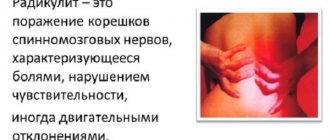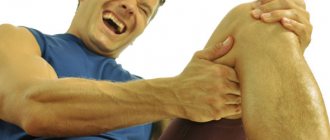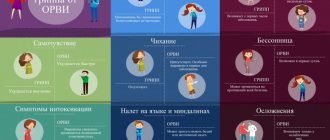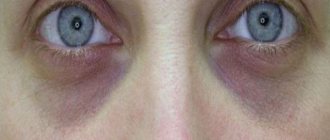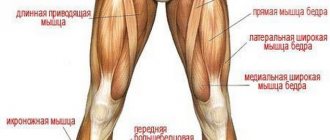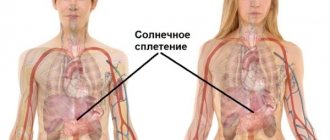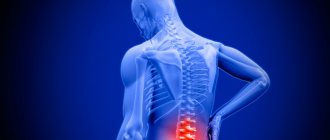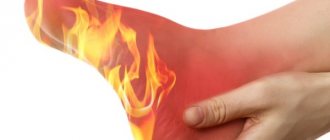Painful lumbago in the back is a very common occurrence, most often they are localized in the lower part, sometimes in the neck, but back pain between the shoulder blades is quite rare. It is impossible to independently identify the cause that led to this condition; you cannot do without the help of a doctor. Most people find that upper back discomfort is not a serious symptom and will go away on its own over time.
The main problem is that pain in this area of the back is not accompanied by strong intensity, so patients do not give it much importance, since this area of the back is inactive. And, as a result, almost all patients do not notice the burning sensation between the shoulder blades and ignore going to a specialist. But the reasons that led to this condition can threaten a person’s life, so under no circumstances should you put off visiting a doctor.
Main reasons ↑
We list the main diseases that can manifest themselves with this symptom:
- traumatic damage to the constituent structures of the thoracic and cervical spine;
- osteochondrotic changes in the thoracic or cervical spine;
- sideways curvature of the spine (scoliosis);
- kyphosis and kyphoscoliosis;
- spondyloarthrosis;
- intercostal hernia;
- hernia between the thoracic vertebrae;
- glenohumeral periarthrosis;
- intercostal neuralgia;
- herpes zoster and some other infectious diseases;
- heart diseases: coronary disease, myocardial infarction;
- pathology of the mediastinum (organs located between the two lungs);
- diseases of the esophagus, stomach, duodenum;
- diseases of the liver and hepatobiliary system;
- diseases of the lungs and their membranes - the pleura;
- kidney pathology;
- frequent performance of a certain type of action against the background of systemic diseases.
In order to understand at least a little about the huge amount of pathology (to know which doctor to contact), we will break down the main causes of pain according to the characteristics of this pain.
In the chest and between the shoulder blades
This usually looks like this:
- kyphosis (curvature of the spine in the anteroposterior direction, convexity backwards);
- scoliosis;
- intervertebral hernia of the thoracic region.
In this case, the pain is present for a long time, has different severity, is usually absent in the morning, and increases in the evening.
In addition, pain can be a symptom of:
- coronary heart disease: in this case, pain occurs at heights of physical activity; it usually goes away with taking a nitroglycerin tablet;
- cholecystitis: then the pain is associated with eating fatty foods;
- hepatitis: it is also characterized by increased bleeding (for example, after brushing teeth), changes in skin color;
- pneumonia and pleurisy: there will also be a cough, increased body temperature, and signs of intoxication.
When inhaling
The causes of pain between the shoulder blades when inhaling can be:
- Intercostal neuralgia. It has a shooting, encircling character. It intensifies with a deep breath, sudden movement of the body, or when palpating the sore area between the ribs. An increase in temperature is typical if neuralgia is caused by the shingles virus. Then small bubbles with clear liquid will be visible on the skin of the diseased area.
- Lung diseases. In this case, pain between the shoulder blades is also present when inhaling, intensifies with a deep breath and is accompanied by an increase in temperature, most often a cough (the absence of a cough does not indicate the absence of pneumonia), weakness, fatigue, and sometimes nausea and lack of appetite.
If the pain intensifies even when you take a deep breath, and the pain is more likely under the right shoulder blade, we may be talking about a diaphragmatic abscess.
After sleep
This is almost always how cervical osteochondrosis manifests itself if you slept in an uncomfortable position.
The “test” in this case will be increased pain when rotating the head or hyperextending it.
Sharp pain in the spine
This symptom in most cases indicates that there is irritation, pinching or inflammation of the roots of one or more spinal nerves.
Read also…. Pain in the back of the head
When you turn your head
This is how diseases of the spine (mainly osteochondrosis) manifest themselves at the level of the lower cervical - upper thoracic vertebrae.
This condition is not accompanied by fever, weakness, or loss of appetite.
When tilting your head
This type of pain manifests itself as inflammation of the muscles of the interscapular region, as well as damage to their tendons, ligaments and places of attachment to the vertebrae.
Between the shoulder blades and in the neck
He almost always talks about diseases of the spine (most often degenerative-dystrophic, that is, osteochondrosis, spondyloarthrosis, ankylosing spondylitis).
The pain can be described as either sharp, shooting, or aching. But it should always be associated with movement, intensifying when turning the head, raising the arms, tilting the neck or placing the hands behind the back.
The pain may worsen at night.
During pregnancy
Typically, such pain indicates an increased load on the spine due to a shift in the center of gravity.
But it goes away after rest and is not accompanied by fatigue or increased body temperature.
The latter symptoms, together with interscapular pain syndrome, may indicate pneumonia or pyelonephritis.
After training
This is how pain manifests itself from overload either in the muscles of this area, or in the thoracic (less often, cervical) spine.
In the morning
An aching, dull pain that occurs in the morning and can wake a person up indicates an exacerbation of osteochondrosis.
It is characterized by a decrease in pain when taking a warm bath and applying a warming cream to this area.
An increase in temperature and intoxication symptoms indicate diseases of the internal organs.
When coughing
Typically, pain when coughing is characteristic of intercostal neuralgia.
But it is also characterized by:
- encircling character;
- paroxysmal;
- pain when palpating the intercostal space.
It can radiate to the heart area, to the lower back, under the shoulder blades, which requires additional studies (ultrasound of the abdomen, ECG, X-ray of the lungs) to exclude diseases of the internal organs.
The pain caused by neuralgia intensifies in a certain position of the body, when walking, or physical activity.
After meal
This is how peptic ulcer manifests itself, mainly of the stomach, but sometimes of the duodenum.
Peptic ulcer disease is confirmed by the fact that it becomes easier if you drink Omez or Ranitidine after vomiting, as well as if you apply a warm heating pad to your back.
In addition to pain, this pathology causes heartburn, belching, and nausea.
When swallowing
The connection between pain between the shoulder blades and swallowing requires mandatory consultation with a doctor.
These can be serious diseases such as:
- inflammation or ulcer in the esophagus;
- inflammation of the organs located between the two lungs (mediastinitis);
- disease of the diaphragm (then, in addition to pain when swallowing, the pain syndrome will intensify under such loads when intra-abdominal pressure increases).
Giving into the hand
This is a symptom of osteochondrosis of the cervical or upper thoracic region.
In this case, the pain intensifies with load on the neck or prolonged uncomfortable position. There may also be dizziness and a feeling of “pins and needles” in the arms.
There should be no fever, vomiting, or weakness.
Gives to the neck
This diagnosis is quite complicated.
This symptom can manifest both spinal diseases and life-threatening pathologies:
- Humeroscapular periarthrosis. In this case, pain in the back and arm is associated with certain movements. They are not accompanied by an increase in temperature or a change in the general condition of a person.
- Biliary colic. It occurs due to blockage of the outflow of bile by a stone. The pain is sharp, stabbing. The general condition also suffers.
- Disease of the aorta - aneurysm. It is characterized by pain, which is localized mainly behind the sternum, radiating under the shoulder blade and into the neck.
- Myocardial infarction. It can very rarely manifest itself in the form of not retrosternal, but interscapular pain, radiating to the neck. Often with this life-threatening disease, the pain will be localized behind the sternum, in the shoulder blade, in the left arm, and in the neck.
Fig.: Aortic aneurysm
Giving into the stomach
This is how a peptic ulcer usually manifests itself - the stomach or upper intestine. Accompanied by nausea, belching, heartburn, and a feeling of bloating.
The pain is associated with eating.
After childbirth
Such pain usually indicates the emergence or exacerbation of spinal pathology:
- kyphoscoliosis;
- disc protrusion;
- scoliosis;
- spondyloarthrosis.
Read also…. Cold neck
But these problems should not cause loss of consciousness, fever, or deterioration in health.
The child has
Almost always this is a sign of developing scoliosis due to poor posture.
In this case, you can notice that the lower corners of the shoulder blades, as well as the shoulders, are at different levels.
If the pain is associated with eating, there are belchings or heartburn, this may be gastritis or peptic ulcer.
The association of pain with eating fatty foods and a feeling of bloating can indicate both biliary dyskinesia and cholecystitis.
In this and the penultimate case, a visit to a pediatric gastroenterologist should not be postponed.
Other diseases
- Osteoporosis with fractures of the vertebral bodies, say, against the background of long-term use of steroid hormones or a drop in estrogen in postmenopausal women.
- Metastasis to the vertebrae of stomach cancer, for example, can also cause pain
- Spontaneous fractures due to irrational loads.
- Ankylochial spondylitis (Bechterew's disease) is a systemic disease. It affects more often men, in which, against the background of inflammation, the vertebrae are affected and ossification of the ligaments occurs. As a result, the spine becomes inflexible and is described radiographically as being like a bamboo stick.
Author:
Selezneva Valentina Anatolyevna physician-therapist
Possible nature of pain ↑
Let us give various examples of diseases based on the nature of pain.
It should be taken into account that there is no direct and 100% guarantee of an accurate diagnosis based only on this criterion, since the pain threshold and sensations for the same disease differ from person to person.
Sharp
Pain of this nature usually appears in response to pinching, inflammation or irritation of one or more spinal nerve roots: this is what used to be called “sciatica”.
It is a consequence of other pathological conditions, for example, osteochondrosis or scoliosis. Because of this, swelling and inflammation occur in the area of the pinched root, which provokes reflex tension in certain back muscles.
As a result of this muscle spasm, the root is pinched even more.
Biliary colic also manifests itself as sharp pains, only they occur not only between the shoulder blades, but also in the area of the right hypochondrium.
In this case, there is a connection between eating fatty, spicy, fried or spicy foods: pain appears 3-5 hours after such a meal.
In addition to pain, general health also suffers, nausea and vomiting appear.
Strong
This word most often describes pain in the following conditions:
- Protrusion of the intervertebral disc;
- Intercostal neuralgia, during which a person is even afraid to take a breath;
- Pancreatitis. It is accompanied by other symptoms: bloating, diarrhea, and general impairment;
- Myocardial infarction. In this case, your well-being also suffers significantly. Loss of consciousness, arrhythmias, and decreased blood pressure often occur.
Fig.: protrusion and herniation of the intervertebral disc
Burning
In this case, two conditions are differentiated - ischemic cardiac pathology (its subtype is angina) and osteochondrosis.
With ischemic heart disease pain:
- it will be burning, squeezing;
- does not last long (only with a heart attack);
- goes away within a few minutes after taking nitroglycerin;
- does not depend on movement;
- subsides at rest.
When a nerve root is pinched, the pain is:
- associated with movement;
- goes away after taking painkillers or when taking a certain position;
- does not respond to nitroglycerin.
Acute
It is observed in the following diseases:
- attack of cholecystitis: appears in response to eating fatty, spicy, fried foods, it also hurts on the right under the ribs
- a stomach ulcer that has opened (penetrated) into the pancreas: in this case, there will be pain not only between the shoulder blades, but also in the abdomen
- exacerbation of osteochondrosis of the thoracic region: such pain arose in response to some kind of movement or lifting of weight.
Aching
This type of pain almost always indicates diseases of the spine and bones:
- kyphoscoliosis;
- intervertebral disc herniation;
- scapular-costal syndrome;
- fibromyalgia;
- spondyloarthrosis.
In some cases, peptic ulcer and ischemic heart disease may manifest themselves this way.
Pulling
This is pain characteristic of musculoskeletal structures:
- myofascial syndrome;
- osteochondrosis of the thoracic or cervical spine;
- scapular-costal syndrome.
Dumb
Almost 90% of the causes of pain described by the characteristic “dull” are pathologies of muscles, tendons and ligaments.
The remaining causes are almost equally divided between osteochondrosis and pathology of internal organs (pneumonia, angina pectoris, cholecystitis, cholelithiasis).
If the cause of the pain is the spine, then it can be described as follows:
- the pain does not radiate to other parts of the body;
- increases with physical activity that involves sore muscles;
- the area hurts when palpated.
Stabbing
This is a symptom of the following conditions:
- Pleurisy. Then, in addition to pain, the person will notice a cough and weakness.
- Beginning perforation of the ulcer. In this case, before this there was abdominal pain, heartburn, nausea, and bloating.
- Vegetative-vascular dystonia.
- Biliary colic.
- Pyelonephritis.
Features of treatment
To treat neck pain that radiates to the shoulder blades, you need to contact a qualified specialist. You can only eliminate pain if you eliminate the cause of its occurrence. Suppressing pain with analgesics is not the best solution, since the disease will continue to progress, leading to complications and deterioration of the general condition. Treatment is usually complex. If the problem lies in pathologies of the musculoskeletal system, for treatment the doctor prescribes:
- medicines;
- exercises;
- massage.
In addition to everything, it is worth using traditional medicine, but not forgetting about the main course of treatment and preliminary consultation with a neurologist .
What signs may accompany pain? ↑
Additional symptoms will help you more accurately determine what disease is causing pain in the interscapular area.
Read also…. Neck pain
The back burns and bakes between the shoulder blades
Causes of this condition:
- Osteochondrosis of the thoracic or cervical spine;
- An attack of biliary colic;
- Reflux esophagitis;
- Renal colic.
Fig.: reflux esophagitis
My back goes numb
Causes of these symptoms:
- thoracic osteochondrosis;
- kyphosis, kyphoscoliosis;
- glenohumeral periarthritis;
- spondyloarthrosis;
- IHD;
- peptic ulcer;
- pleurisy;
- pneumonia;
- biliary dyskinesia.
My back itches
This is a rather rare combination of symptoms - pain between the shoulder blades and itching of the back.
It can occur with biliary colic, as well as with herpes zoster.
My back is freezing
This combination of symptoms may be characteristic of one of two diseases:
- pinching of the spinal nerve root, in which sensory fibers pass;
- exacerbation of chronic pyelonephritis.
Temperature
If the pain between the shoulder blades is accompanied by an increase in temperature, this is typical for diseases of the internal organs:
- pneumonia
- tuberculosis of the lung or bones
- hepatitis
- cholecystitis
- pancreatitis
- pyelonephritis.
Cough
Cough and pain between the shoulder blades are accompanied by diseases of the bronchopulmonary system:
- tracheitis;
- pneumonia with pleurisy;
- tuberculosis;
- lung tumor.
Fig.: pulmonary tuberculosis
Breathe heavily
This is a clear sign of lung damage.
This combination of symptoms manifests itself as pleurisy and pneumonia.
Lump in the throat
Indicates that the esophagus is suffering - this could be inflammatory diseases, tumors, or varicose veins in the esophagus due to cirrhosis of the liver.
Nausea
Pain between the shoulder blades in combination with nausea is manifested by:
- peptic ulcer;
- myocardial infarction;
- subphrenic abscess;
- liver diseases;
- kidney diseases.
Belching
These two signs - pain between the shoulder blades and belching - almost always indicate damage to the upper gastrointestinal tract.
So, these could be: gastroesophageal reflux, gallstones and peptic ulcers.
Dyspnea
This is a symptom, which in itself indicates that you urgently need the help of a doctor, since the condition is life-threatening.
This combination of symptoms manifests itself:
- pneumonia;
- pericarditis;
- pneumothorax.
Prevention
Good posture, keeping the muscles in your upper back strong, and avoiding heavy lifting can prevent pain between your shoulder blades.
People who sit at a desk for long periods of time can use a comfortable chair to prevent upper back pain. They should keep their spine in a natural position without bending their shoulders or pulling their neck forward.
Regular exercise can help you maintain a moderate weight, which reduces stress on your back.
Stress can cause tension in your upper back and shoulders. Yoga and stretching exercises can help relieve tense muscles.
What to do? ↑
It is not recommended to endure pain in this localization for more than an hour.
If it is accompanied by shortness of breath, fever, weakness, cough and hemoptysis, you need to call a doctor and not guess about the origin of such pain.
If there are no such symptoms, you can try to eliminate the pain yourself.
Exercises
- We place our hands on our shoulders, make circular movements with our elbows, several times back and forth.
- We raise our hands up, then raise our arms ourselves, closing our palms above our heads. At the same time, the head lowers, the gaze is fixed on the hands.
- We turn the body left and right (twisting).
Video: exercises for back pain
Massage
You can do self-massage.
For this:
- We clench our hands into fists, sticking out our thumbs, and place them on the lower back. We move our finger so that the fist slowly moves towards the cervical spine.
- You can also make stroking movements with one or two hands along the spine.
If the massage becomes more painful, this indicates the presence of inflammation. It needs to stop.
Video: self-massage for back pain
Other self-treatment methods
They include applying to the area where maximum pain is felt, both ointments prepared independently from herbs and official medicine:
- "Fastum gel";
- "Diclofenac" or "Voltaren" gel;
- Take 50 ml of dry mustard, camphor alcohol and vodka, mix with 3 beaten egg whites. Mix all components, leave for 10 hours in a dark place, then can be used as a compress.
- Mix 100 grams of honey, 50 ml of aloe juice, 150 ml of vodka. Leave for 12 hours, apply as a compress.
Which doctors should I contact?
The list of doctors begins with a general practitioner.
Then come more specialized specialists:
- gastroenterologist;
- vertebrologist or neurologist;
- nephrologist;
- traumatologist;
- cardiologist;
- urologist.
How is diagnosis carried out?
Determining the causes of pain between the shoulder blades is not an easy task because it is a symptom of a large number of diseases. To make a correct diagnosis, the doctor will need to conduct several studies and collect tests.
The doctor must conduct a diagnosis, which will include various tests and images to accurately determine the disease
If for a hernia it is enough to take an MRI and CT scan, as well as a blood test, then in this case you will also have to undergo an X-ray and an electrocardiogram, be examined by a cardiologist, a surgeon, and for women, also by a gynecologist. Sometimes doctors only perform palpation, and in more “advanced” cases this is enough to determine the correct diagnosis.
Classification
In almost all diseases, in addition to heaviness in the shoulder blades, pain also occurs. Such pain is divided into chronic and acute.
- Acute occurs suddenly, severely, with lumbago, long-lasting pain.
- Chronic pain can be aching, pulling, or dull. They either constantly pursue a person, then retreat for a while, then arise again, sometimes with greater force and intensity.
Sometimes the pain is burning and baking. Such pains are the most dangerous; they can be a manifestation of a heart attack, kidney complications, or inflammation of the esophageal mucosa.
